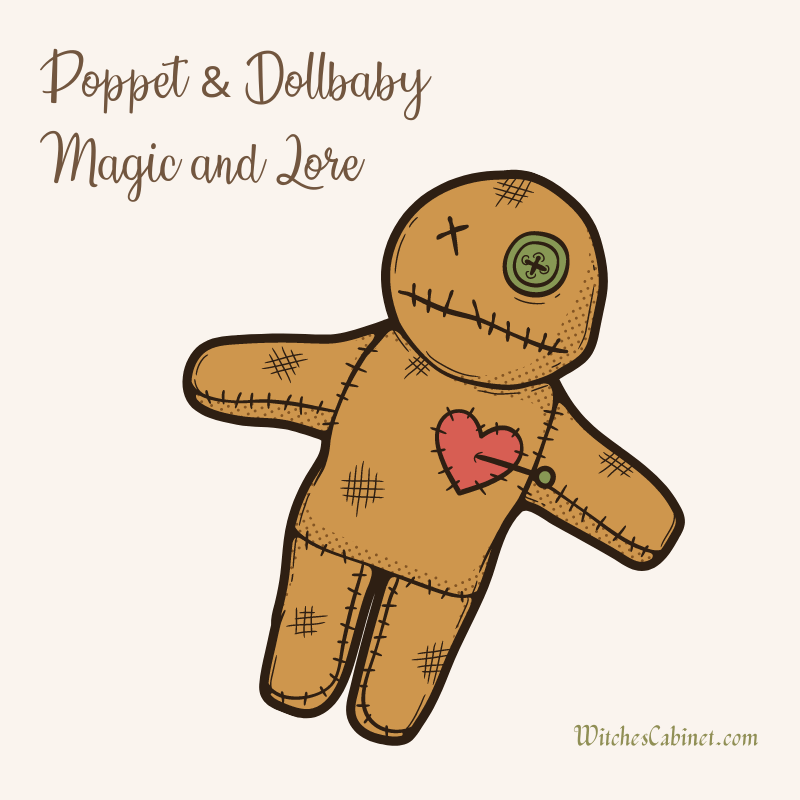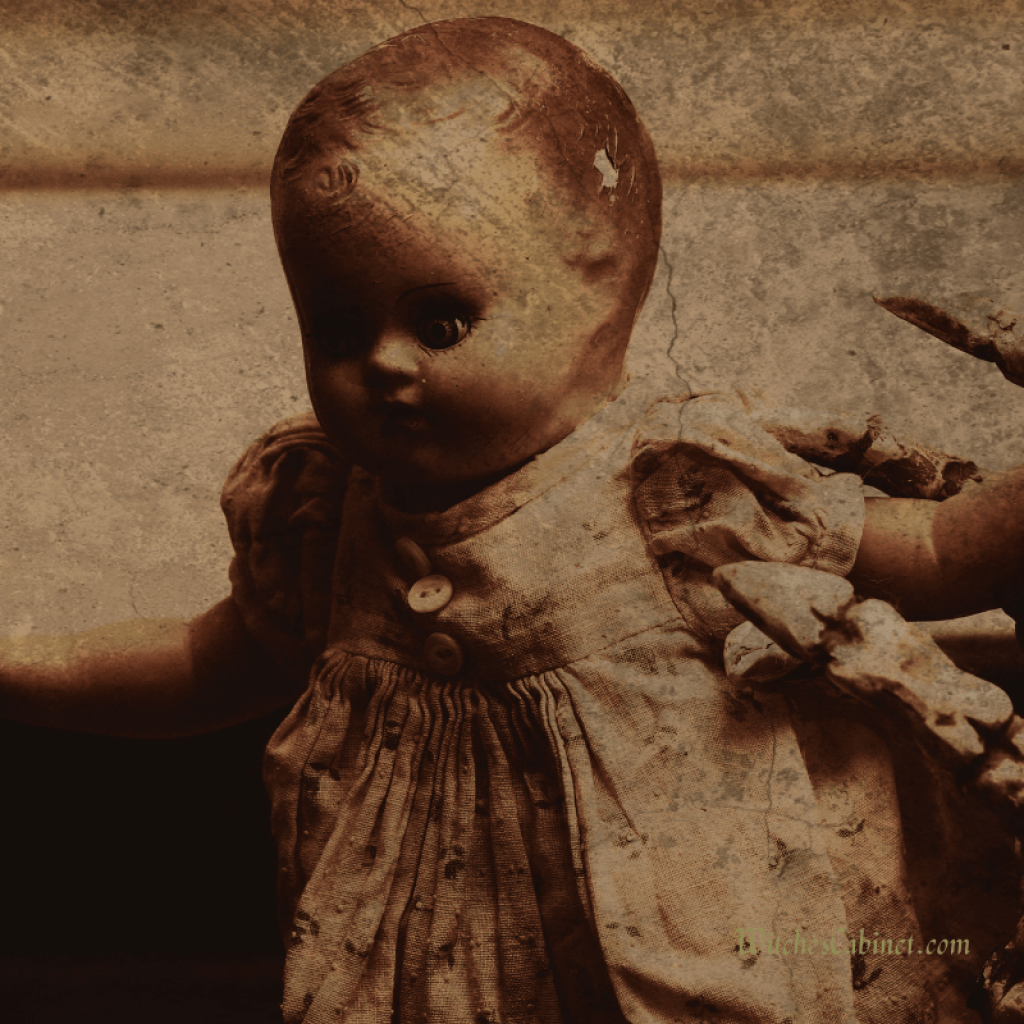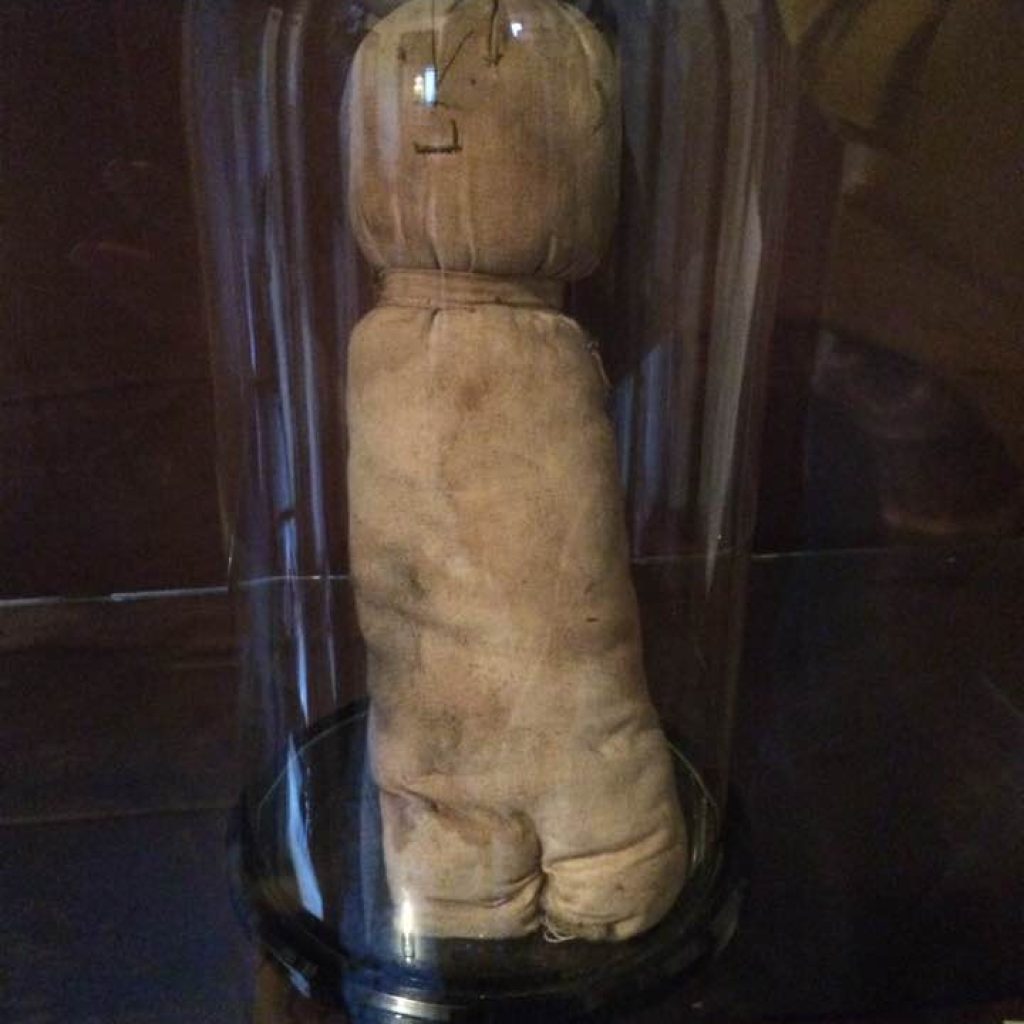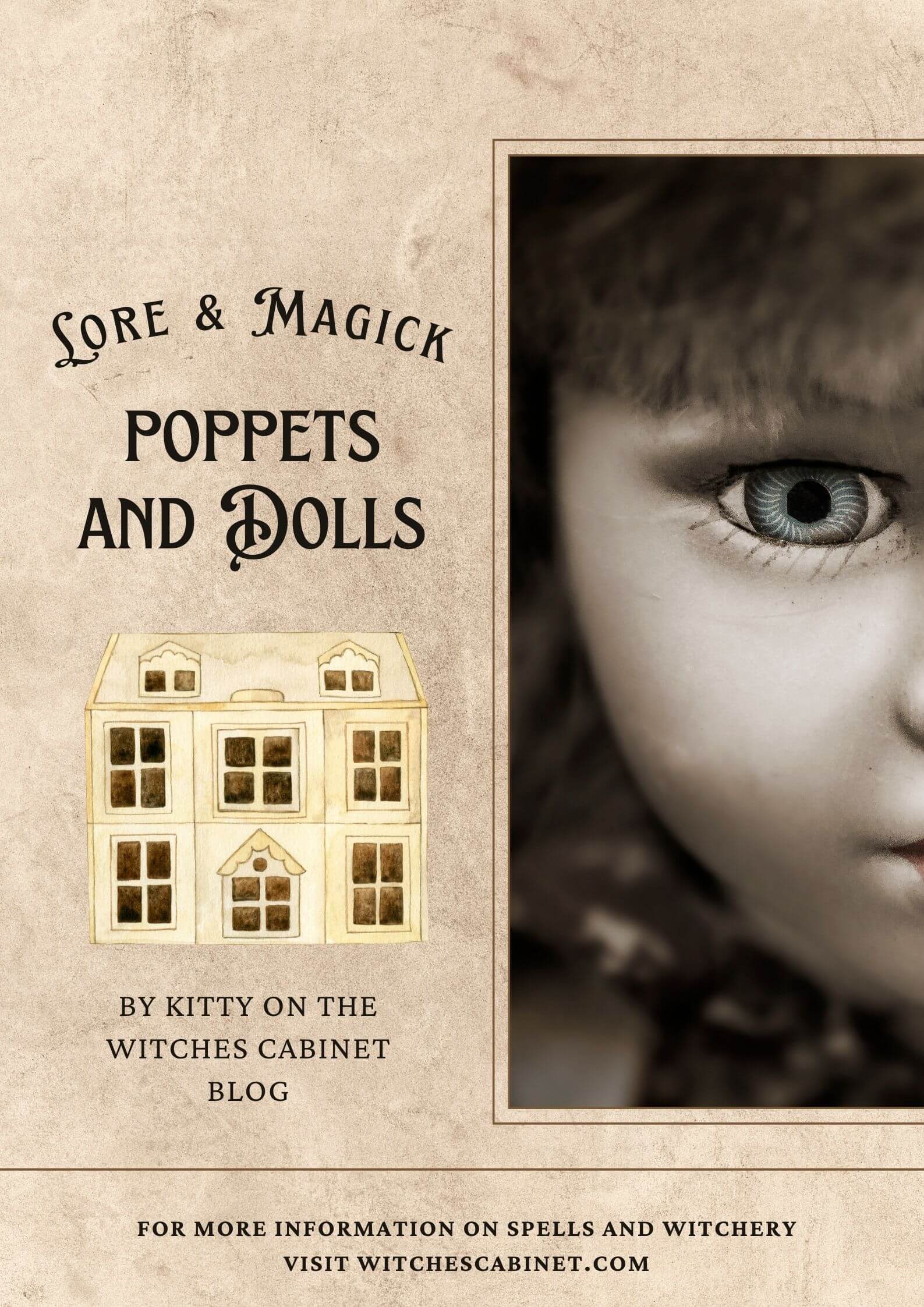Poppets: The Mystical History of Dolls and How to Make Them

Most little girls own a doll or two. Some own an entire room full of babydolls and stuffed animals. I’ll bet you likely owned a doll of your own, if you’re reading this right now. And if not, then you’re here because you’re interested in dolls. In their mystical origins, history, and magic. You might even be wondering about a haunted doll or how to make your own. In this post, we will not only meet the first doll, but we will learn how to craft and enchant our very own poppets.
Ancient Idols: The Very First Dolls or Poppets
The word doll originates in seventeenth century England, according to online sources, and means “a small human figure”. Yet I believe this word’s origins go much deeper than this. Judika Illes mentions in her Encyclopedia of Witchcraft that the word doll sounds and looks like the word idol. And what is an idol? According to the dictionary, an idol is “an image or representation of a god used as an object of worship”. In addition, another definition is “a person or thing that is greatly admired, loved, or revered.” So, if we look at the doll in this light, we can see just how important in the realm of spirits and magic these little “toys” might be.
The word poppet, which is synonymous with the word doll in witchcraft, has a few definitions as well. The first says a poppet is a term of endearment used for a “small child or person that you love”. Its etymology is derived from the Latin word puppa, which became poppet in Late Middle English meaning a “girl, doll”.
Interestingly, you might have noticed the word poppet sounds an awful lot like the word puppet. And while they seem like the same, if we research the origins of the word puppet, we see a more negative connotation attached. A puppet is a doll that is led around by its strings, therefore easily controlled. This term has been applied to politicians in modern times, and also somehow is connected to the words pupil which originally didn’t mean student but meant an orphan or ward of the state.
If we look for the very first doll or idol, we discover some interesting evidence from prehistory…the Venus of Willendorf. The Venus of Willendorf is a tiny (standing at about 5 cm tall) figurine that was discovered in an archaeological dig in Austria. This tiny faceless statue with a voluptuous feminine body is believed to be about 25,000 years old. And is probably the oldest idol or doll we have from human history. Why did Paleolithic man create this tiny idol? Was the Venus of Willendorf a toy? There are a few theories as to why the doll-like statue was crafted, ranging from fertility magic to self portraits. We don’t really know why she was made, but it turns out she’s actually one of thousands uncovered all over the world. So the art of crafting dolls in our image is one of the oldest art forms next to cave paintings.
One of the oldest dolls we have in our possession is the ancient Egyptian paddle doll from the Middle Kingdom circa 2000 BCE. These dolls are made of wood and are literally in the shape of a paddle. Scholars believe these dolls were specifically made for ritual purposes and not played with. We also have evidence of dolls in Ancient Greece and Rome that were sacred to little girls. And when those little girls grew up and married, they would then offer their dolls to the Goddess.
Dolls were frequently used as effigies to represent the owner in some way. For instance, in ancient thermal springs throughout Europe, we’ve found dolls and doll parts that were likely ritually thrown into the springs. A hand or leg thrown in to the springs in hopes the god or goddess there would heal the owner’s ailing limb.
In ancient Hebrew lore, we have the golem which is a creature made of clay or mud that’s almost human but not quite. While this being might not be considered a “doll” to some, there are some definite similarities. A human-shaped figure is crafted and is first inanimate, only to be animated by supernatural forces and “come alive”. There’s a famous story of a golem in Prague who was brought to life by a Rabbi during the sixteenth century. This creature had the sole duty of protecting the Jews in the Prague ghetto from antisemitic attacks. Apparently, this clay figure while in animated mode had the ability to summon the dead as backup! But on Friday evenings, the Rabbi would put the Golem to sleep so as to give it rest the following day on the Sabbath.

Haunted Dolls Or How Poppets Come Alive
I think we’ve determined that dolls, while seemingly inanimate objects for play, can be much more than meets the eye. Throughout history they’ve been employed as ritual objects, toys, and as vessels for spirits. Sometimes very powerful spirits take up residence in dolls. Which brings me to my next point – haunted dolls.
You might have heard of two of the most famously haunted dolls in the world. They’re names are Annabelle and Robert the Doll. Annabelle has gained popularity in the popular horror movie franchise Annabelle, and her story is based on true events. There is a raggedy ann doll that is housed in Zac Bagan’s collection that was once in the Warrens’ Occult Museum. She is known to have caused numerous tragedies and for her owners to be ill and injured. Annabelle is now kept in a case to prevent further incidents.
The other famous haunted doll named Robert the Doll is housed in a museum in Key West, Florida. And is well known for his antics, even now. In fact, when you visit Robert, legend has it that you should always ask his permission before photographing him. Visitors claim to see Robert’s head turn slightly and hear giggles from time to time.
How does a doll become haunted?
There is more than one way for a doll to become haunted or inhabited by a spirit. First, residual energy. This is energy that has been transferred to the doll through a living person or environment. For example, a teen girl holds onto her childhood doll while going through a trying, sad time. Her emotional energy is transferred into the doll. If there’s enough of this energy and the energy is strong enough, it can develop a thought form and “animate” the doll. Making it “haunted”.
Secondly, human spirits who were once alive may take up residence within a doll. Dolls make for easy vessels to inhabit by human spirits because most dolls look like humans. They even have much of our anatomy: head, body, arms, legs, face, etc. So, old woman dies and isn’t ready to pass onto the afterlife, and decides to attach herself to the doll in her bedroom instead. It’s a nearby vessel that was dear to her and even looks a little like she did as a young girl. Easy vessel. Other spirits can inhabit dolls in this way, as well, including lower level beings and tricksters.
A third way a doll may become haunted is intentionally through magic or ritual. A witch makes a poppet from wax and herb. She molds it between her hands, magic radiating from her flowing into the little figure. The herbs she sprinkles on the poppet all match her intention. And when she’s done, she invokes a spirit of the hearth to take up residence in the poppet. This can be any spirit including fae, ancestor, genius loci, elemental, ghost, or familiar. Anything the witch summons. It can also be a servitor, which is basically a spirit created by the witch’s mind for a specific purpose that will be dissipated once its job is done.
Poppets and Magical Babydolls in Modern Times
Since dolls and poppets have been used for centuries as toys and ritual items, it’s no wonder they are still in use today. I would venture to say most of the dolls out there have a main purpose of being a child’s plaything. But there are still dolls being made by witches and conjurors for the purpose of housing spirits and/or manifesting a specific intention. And even though the doll in a magical sense has gotten a bad rap through the likes of the Voodoo Doll, I would bet most poppets made by a magical practitioner are likely for benevolent purposes. Rather than for maleficia.
A few reasons poppets are crafted for magical reasons today include for healing, protection, comfort, to draw love or friendship, as an offering to specific deities or familiars, and to house spirits as vessels. They may be crafted and employed to do harm on a target, when used with darker intentions. Or used to bind a person from causing harm to themselves or others. I’ve personally made a kitchen witch doll to be employed as a guardian and good luck charm over my kitchen.

How to Craft Your Own Poppet (or Doll)
First, I think terminology is crucial here. Are you creating a doll that you want to house a sentient spirit and give it its own power? Then you’d call it a doll (as in idol). But if you want to control the intention and energy going into and coming out of this doll, you should technically call it a poppet. Meaning, you hold the strings, you have the power. Not the poppet.
Next, decide what your intention is for this poppet. Will it be used as a means of healing? Protection? To draw love to someone or yourself? Or is it going to be used for a binding ritual to prevent someone from causing harm? Etc. Focus on the intention and then decide what you’ll use to construct your doll.
For example, if this poppet will be used as a protective toy for a child, you’d best choose soft fabrics and items to paint or construct a friendly face. Stuffing with a few herbs might do this poppet well. But if you’re looking to bind the target from doing harm, making the poppet out of wax or clay might be best so that you can easily dispose of the spell when it’s run its course.
What You’ll Need:
- Basic shape (body) made of: fabric, sticks, wax, wood, clay, etc.
- If you’re using fabric to construct your poppet, you might also need a doll pattern OR cookie cutter with which to draw out your doll’s body. In addition, scissors and pins.
- Thread, sewing machine, needles, glue, something to bind the poppet together
- Stuffing: if using fabric…herbs, lint, stuffing of some kind
- Decorations: paint for the face, buttons as eyes, stitching for mouth, ribbons, etc.
- Personal effects: if making the poppet in someone’s image, personal effects include anything like a photo, paper with personal info, hair, nail clippings, clothing worn by the person, etc.
How to Craft Magical Poppets:
- Gather your supplies. Cleanse your space and get into the right headspace to make magick.
- Think of your poppet as a living being, or at the very least, a vessel to hold the essence or spirit of your intentions or intended target.
- Begin constructing your poppet starting with your base material, singing and chanting your intentions over the poppet at every step.
- Add herbs and other magical items that align with your intentions to enchant the poppet and build its power.
- Add your target’s personal effects before sewing up the poppet or before finishing your clay/wax poppet. Begin calling the poppet by name and treating it as if it is alive and/or has consciousness.
- Set the poppet somewhere appropriate. For example, if your poppet is an image of yourself and you created it for emotional healing, place it near a water source like the bathtub. If your poppet is to draw love into your life, place it under the bed or somewhere close to you in your bedroom. If it’s to bind a target, you’ll place it somewhere safe and dark like in a lock box or drawer that won’t be disturbed.
- Once the poppet magic has run its course, dispose of it accordingly. Some folks keep their poppets for life, depending on what the original intention was. For bindings, you have the option of burying the poppet after un-binding the target off of your property. For healing poppets, you also have the option of burying in the west. Learn more about disposing of spell remnants here.

About The Author
nicolemcanfield
Related Posts
2 Dollar Bill Spiritual Meaning PLUS Money Spells & Rituals
Have you ever seen or held a 2 dollar bill in your hand? Honestly, I …
November 11, 2023Vampire Blood Incense: Dark, SEDUCTIVE Properties and Uses
It’s the middle of the night and you’re conjuring something ancient. Something forbidden. Something…undead. You …
October 10, 2023


Leave A Comment